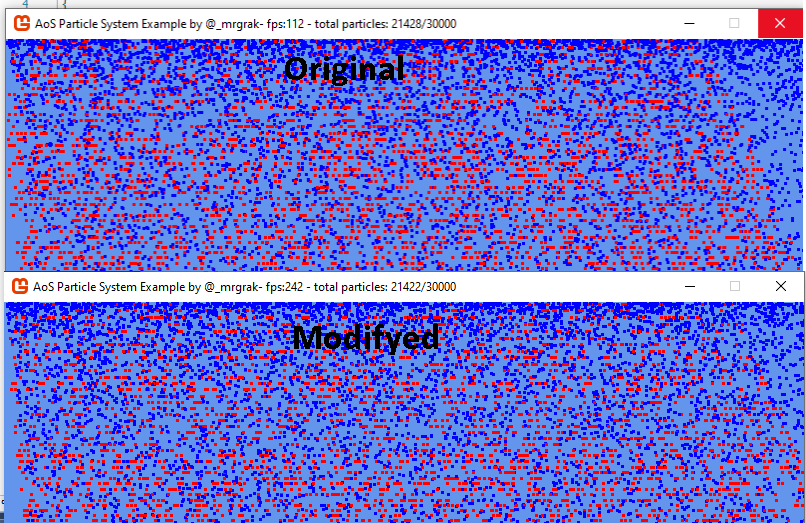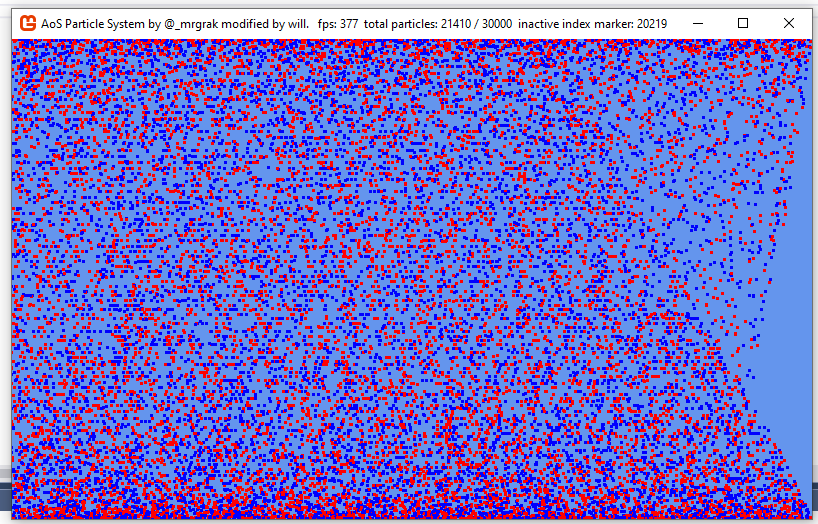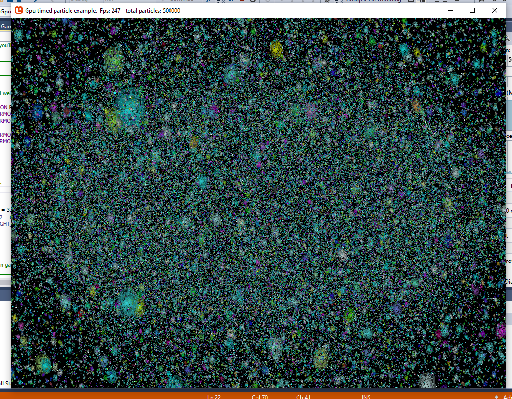Just wanted to post up a link to this for reference anyone trying to understand how to do particles cpu side.
Or the basic idea for iterating a array of structs quickly for a lot of little game objects.
This is basically the original code if you would like to see it progress.
using System;
using Microsoft.Xna.Framework;
using Microsoft.Xna.Framework.Graphics;
using System.Diagnostics;
using Microsoft.Xna.Framework.Content;
namespace MrGraksAosExampleOriginal
{
public static class Data
{
public static GraphicsDeviceManager GDM;
public static ContentManager CM;
public static SpriteBatch SB;
public static Game1Original GAME;
}
public struct Physics
{
public float X, Y; //current position
public float accX, accY; //accelerations
public float preX, preY; //last position
}
public enum ParticleID : byte { Inactive, Fire, Rain }
public struct Particle
{ //uses physics struct as component
public Physics physics;
public Color color;
public float alpha;
public ParticleID Id;
public short age;
}
public static class ParticleSystem
{ //max size depends on the platform, 30k is baseline/lowend
public const int size = 30000;
public static int active = 0;
public static Particle[] data = new Particle[size];
static Random Rand = new Random();
public static Texture2D texture;
public static Rectangle drawRec = new Rectangle(0, 0, 3, 3);
public static float gravity = 0.1f;
public static float windCounter = 0;
public static void Reset()
{ //acts as a constructor as well
if (texture == null)
{ //set up a general texture we can draw dots with, if required
texture = new Texture2D(Data.GDM.GraphicsDevice, 1, 1);
texture.SetData<Color>(new Color[] { Color.White });
}
//reset particles to inactive state
for (int i = 0; i < size; i++)
{ data[i].Id = ParticleID.Inactive; }
active = 0; //reset active count too
}
public static void Spawn(
ParticleID ID, //type of particle to spawn
float X, float Y, //spawn x, y position
float accX, float accY //initial x, y acceleration
)
{ //create a stack instance to work on
Particle P = new Particle();
//setup P based on parameters
P.physics.X = X; P.physics.preX = X;
P.physics.Y = Y; P.physics.preY = Y;
P.physics.accX = accX;
P.physics.accY = accY;
//set defaults for particle
P.alpha = 1.0f;
P.age = 0;
P.color = Color.White;
//pass the ID
P.Id = ID;
//setup particle based on ID
if (P.Id == ParticleID.Fire)
{ //fire is red, for instance
P.color = Color.Red;
}
else if (P.Id == ParticleID.Rain)
{ //rain is blue, this could be an animated sprite tho
P.color = Color.Blue;
}
//find an inactive particle to copy data to
int s = size;
for (int i = 0; i < s; i++)
{ //read each struct once
if (data[i].Id == ParticleID.Inactive)
{ //write local to heap once
data[i] = P;
active++;
return;
} //if all are active,
} //fail silently/ignore
}
static int fireEndMarker = 0;
static int rainEndInactiveIndexMarker = 0; // this is the dead index.
public static void Update()
{ //step 1 - update/animate all the particles
//step 2 - randomly spawn fire and rain particles
//increase wind counter
windCounter += 0.015f;
//get left or right horizontal value for wind
float wind = (float)Math.Sin(windCounter) * 0.03f;
//store locals for this heap data
int width = Data.GDM.PreferredBackBufferWidth;
int height = Data.GDM.PreferredBackBufferHeight;
//step 1 - update all active particles
int s = size;
for (int i = 0; i < s; i++)
{ //particle active, age + check id / behavior
if (data[i].Id > 0)
{ //create a local copy
Particle P = data[i];
//age active particles
P.age++;
//affect particles based on id
if (P.Id == ParticleID.Fire)
{ //fire rises, gravity does not affect it
P.physics.accY -= gravity;
P.physics.accY -= 0.05f;
//has longer life than rain
if (P.age > 300)
{
P.Id = ParticleID.Inactive;
}
}
else if (P.Id == ParticleID.Rain)
{ //rain falls (at different speeds)
P.physics.accY = Rand.Next(0, 100) * 0.001f;
//has shorter life than fire
if (P.age > 200)
{
P.Id = ParticleID.Inactive;
}
//use behavior field here for additional states
}
//add gravity to push down
P.physics.accY += gravity;
//add wind to push left/right
P.physics.accX += wind;
//calculate velocity using current and previous pos
float velocityX = P.physics.X - P.physics.preX;
float velocityY = P.physics.Y - P.physics.preY;
//store previous positions (the current positions)
P.physics.preX = P.physics.X;
P.physics.preY = P.physics.Y;
//set next positions using current + velocity + acceleration
P.physics.X = P.physics.X + velocityX + P.physics.accX;
P.physics.Y = P.physics.Y + velocityY + P.physics.accY;
//clear accelerations
P.physics.accX = 0; P.physics.accY = 0;
//cull particle if it goes off screen
if (P.physics.X < 0 || P.physics.X > width)
{ P.Id = ParticleID.Inactive; }
else if (P.physics.Y < 0 || P.physics.Y > height)
{ P.Id = ParticleID.Inactive; }
//decrement active value upon particle expiration
if (P.Id == ParticleID.Inactive) { active--; }
//write local to heap
data[i] = P;
}
}
for (int i = 0; i < 100; i++)
{ //step 2 - randomly spawn rain + fire
Spawn(ParticleID.Rain, Rand.Next(0, width), 0, 0, 0);
Spawn(ParticleID.Fire, Rand.Next(0, width), height, 0, 0);
}
}
public static void Draw()
{ //open spritebatch and draw active particles
Data.SB.Begin(SpriteSortMode.Deferred,
BlendState.AlphaBlend, SamplerState.PointClamp);
int s = size;
for (int i = 0; i < s; i++)
{ //if particle is active, draw it
if (data[i].Id > 0)
{ //create vector2 that draw wants
Vector2 pos = new Vector2(data[i].physics.X, data[i].physics.Y);
//draw each particle as a sprite
Data.SB.Draw(texture,
pos,
drawRec,
data[i].color * data[i].alpha,
0,
Vector2.Zero,
1.0f, //scale
SpriteEffects.None,
i * 0.00001f);
} //layer particles based on index, as simple example
}
Data.SB.End();
}
}
public class Game1Original : Game
{
public static Stopwatch timer = new Stopwatch();
public static long ticks = 0;
public static float frames = 0;
public static float secondTimer = 0;
public static float fps = 0;
public Game1Original()
{
//set data game refs
Data.GDM = new GraphicsDeviceManager(this);
Data.GDM.GraphicsProfile = GraphicsProfile.HiDef;
Data.CM = Content;
Data.GAME = this;
Content.RootDirectory = "Content";
IsMouseVisible = true;
}
protected override void Initialize() { base.Initialize(); }
protected override void LoadContent()
{
Data.SB = new SpriteBatch(GraphicsDevice);
ParticleSystem.Reset(); //acts as constructor
}
protected override void UnloadContent() { } //lol
protected override void Update(GameTime gameTime)
{
timer.Restart();
base.Update(gameTime);
ParticleSystem.Update();
}
protected override void Draw(GameTime gameTime)
{
GraphicsDevice.Clear(Color.CornflowerBlue);
base.Draw(gameTime);
ParticleSystem.Draw();
timer.Stop();
ticks = timer.ElapsedTicks;
frames++;
secondTimer += (float)timer.Elapsed.TotalSeconds;
if (secondTimer > 1.0f)
{
secondTimer = 0f;
fps = frames;
frames = 0;
}
Data.GAME.Window.Title = "AoS Particle System Example by @_mrgrak"
//+ "- ticks per frame:" + ticks +
+ "- fps:" + fps +
" - total particles: " + ParticleSystem.active +
"/" + ParticleSystem.size;
}
}
}


